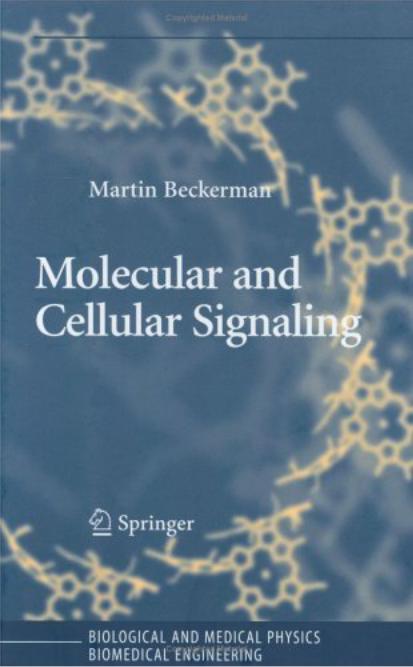
Molecular and Cellular Signaling - Martin Beckerman
.pdf

BIOLOGICAL AND MEDICAL PHYSICS
BIOMEDICAL ENGINEERING

Martin Beckerman
Molecular and
Cellular Signaling
With 227 Figures

Martin Beckerman
Y12 National Security Complex Oak Ridge, TN 37831-7615 USA beckermanm@y12.doe.gov
Library of Congress Cataloging-in-Publication Data Beckerman, Martin.
Molecular and cellular signaling/Martin Beckerman.
p. cm.—(Biological and medical physics, biomedical engineering, ISSN 1618-7210) Includes bibliographical references and index.
ISBN 0-387-22130-1 (alk. paper)
1. Cellular signal transduction. I. Title. II. Series.
QP517.C45B43 2005 |
|
|
571.7¢4—dc22 |
2004052556 |
|
ISBN-10: |
0-387-22130-1 |
Printed on acid-free paper. |
ISBN-13: |
978-0387-22130-4 |
|
© 2005 Springer Science+Business Media, Inc.
AIP Press is an imprint of Springer Science+Business Media, Inc.
All rights reserved. This work may not be translated or copied in whole or in part without the written permission of the publisher (Springer Science+Business Media, Inc., 233 Spring Street, New York, NY 10013, USA), except for brief excerpts in connection with reviews or scholarly analysis. Use in connection with any form of information storage and retrieval, electronic adaptation, computer software, or by similar or dissimilar methodology now know or hereafter developed is forbidden.
The use in this publication of trade names, trademarks, service marks, and similar terms, even if they are not identified as such, is not to be taken as an expression of opinion as to whether or not they are subject to proprietary rights.
Printed in the United States of America. |
(BS/EB) |
|
9 8 7 6 5 4 3 2 1 |
SPIN 10948309 |
|
springeronline.com |
|
|

Series Preface
The fields of biological and medical physics and biomedical engineering are broad, multidisciplinary, and dynamic. They lie at the crossroads of frontier research in physics, biology, chemistry, and medicine. The Biological and Medical Physics/Biomedical Engineering series is intended to be comprehensive, covering a broad range of topics important to the study of the physical, chemical, and biological sciences. Its goal is to provide scientists and engineers with textbooks, monographs, and reference works to address the growing need for information.
Books in the series emphasize established and emergent areas of science including molecular, membrane, and mathematical biophysics; photosynthetic energy harvesting and conversion; information processing; physical principles of genetics; sensory communications; and automata networks, neural networks, and cellular automata. Equally important will be coverage of applied aspects of biological and medical physics and biomedical engineering, such as molecular electronic components and devices, biosensors, medicine, imaging, physical principles of renewable energy production, advanced prostheses, and environmental control and engineering.
Oak Ridge, Tennessee |
ELIAS GREENBAUM |
|
Series Editor-in-Chief |
v

Preface
This text provides an introduction to molecular and cellular signaling in biological systems. Cells partition their core cellular processes into a fixed infrastructure and a control layer. Proteins in the control layer, the subject of this textbook, function as signals, as receptors of the signals, as transcription factors that turn genes on and off, and as signaling transducers and intermediaries. The signaling and regulatory proteins and associated small molecules make contact with the fixed infrastructure responsible for metabolism, growth, replication, and reproduction at well-defined control points, where the signals are converted into cellular responses.
The text is aimed at a broad audience of students and other individuals interested in furthering their understanding of how cells regulate and coordinate their core activities. Malfunction in the control layer is responsible for a host of human disorders ranging from neurological disorders to cancers. Most drugs target components in the control layer, and difficulties in drug design are intimately related to the architecture of the control layer. The text will assist students and individuals in medicine and pharmacology interested in broadening their understanding of how the control layer works. To further that goal, there are chapters on cancers and apoptosis, and on bacteria and viruses. In those chapters not specifically devoted to pathogens, connections between diseases, drugs, and signaling are made.
The target audience for this text includes students in chemistry, physics, and computer science who intend to work in biological and medical physics, and bioinformatics and systems biology.To assist them, the textbook includes a fair amount of background information on the main points of these areas. The first five chapters of the book are mainly background and review chapters. Signaling in the immune, endocrine (hormonal), and nervous systems is covered, along with cancer, apoptosis, and gene regulation.
Biological systems are stunningly well engineered. Proof of this is all around us. It can be seen in the sheer variety of life on Earth, all built pretty much from the same building blocks and according to the same assembly rules, but arranged in myriad different ways. It can be seen in the relatively modest sizes of the genomes of even the most complex organisms, such as
vii

viii Preface
ourselves. The genomes of worms, flies, mice, and humans are roughly comparable, and only a factor of two or three larger than those of some bacteria. The good engineering of biological systems is exemplified by the above-mentioned partition of cellular processes into the fixed infrastructure and the control layer. This makes possible machinery that always works the same way in any cell at any time, and whose interactions can be exactly known, while allowing for the machinery’s regulation by the variable control layer at well-defined control points.
Another example of good engineering design is that of modularity of design. Proteins, especially signaling proteins, are modular in design and their components can be transferred, arranged, and rearranged to make many different proteins. The protein components interact with one another through their interfaces. There are interfaces for interactions with other proteins and with lipids DNA and RNA. Modularity is encountered not only in the largely independent components, but also in the DNA regulatory sequences. These sequences serve as control points for the networks that regulate gene expression. The DNA regulatory sequences can also be rearranged in a multitude of ways along the chromosomes, and these rearrangements, rather than the genes themselves, are largely responsible for the richness of life on Earth. Two of the key objectives of the text are to examine how modularity in design is used and how interfaces are exploited. X-ray crystal structures and nuclear magnetic resonance (NMR) solution structures provide insights at the atomic level of how the interfaces between modules operate, and these will be looked at throughout the text.
One of the great conceptual breakthroughs in explorations of the control layer was the idea that signaling proteins involved in cell-to-cell communication are organized into signaling pathways. In a signaling pathway, there is a starting point, usually a receptor at the plasma membrane, and an endpoint (control point), more often than not a transcription regulatory site in the nucleus, and there is a linear route leading from one to the other.
In spite of the enormous complexity of metazoans, there are only about a dozen or so such pathways. These will be explored in the context of where they are most strongly associated. For example, some pathways are prominent during development and are best understood in that context. Other pathways are associated with stress responses and are best understood within that framework, and still others are associated with immune responses.
Signaling and the cellular responses to signals are complex. The responses are controlled by a plethora of positive and negative feedback loops. The presence of feedback complicates the simple picture of a linear pathway, but this aspect is an essential part of the signaling process. Positive feedback ensures that once the appropriate thresholds are passed there will be a firm commitment to a specific action and the system will not jump back and forth between alternative responses. Negative feedback generates the thresholds that ensure random excursions and perturbations do not unnec-

Preface ix
essarily commit the cell to some irreversible response when it ought not to, and it permits the cells to turn off the signaling once it has served its purpose. These feedback loops will be examined along with the discussions of the linear signaling pathways.
The goal of this textbook is to provide an introduction to the molecular and cellular signaling processing comprising the control layer. The topic is a vast one, and it is not possible to cover every possible aspect and still keep the text concise and readable. To achieve the stated goal, material of a historical nature has been omitted, as have lengthy descriptions of all proteins identified as being involved in the particular aspect of signaling being considered. In place of such an encyclopedic approach, selected processes are presented step-by-step from start to end. These examples serve as simple models of how the control process is carried out.
Oak Ridge, Tennessee |
MARTIN BECKERMAN |

Contents
Series Preface . . . . . . . . . . . . . . . . . . . . . . . . . . . . . . |
v |
|
Preface . . . . . . . . . . . . . . . . . . . . . . . . . . . . . . . . . . |
vii |
|
Guide to Acronyms . . . . . . . . . . . . . . . . . . . . . . . . . . . |
xxv |
|
1. Introduction . . . . . . . . . . . . . . . . . . . . . . . . . . . . |
1 |
|
1.1 |
Prokaryotes and Eukaryotes . . . . . . . . . . . . . . . |
1 |
1.2 |
The Cytoskeleton and Extracellular Matrix . . . . . . |
2 |
1.3 |
Core Cellular Functions in Organelles . . . . . . . . . |
3 |
1.4Metabolic Processes in Mitochondria and
|
Chloroplasts . . . . . . . . . . . . . . . . . . . . . . . . |
4 |
1.5 |
Cellular DNA to Chromatin . . . . . . . . . . . . . . . |
5 |
1.6Protein Activities in the Endoplasmic Reticulum and
|
Golgi Apparatus . . . . . . . . . . . . . . . . . . . . . . |
6 |
1.7 |
Digestion and Recycling of Macromolecules . . . . . . |
8 |
1.8Genomes of Bacteria Reveal Importance of
|
Signaling . . . . . . . . . . . . . . . . . . . . . . . . . . |
9 |
1.9 |
Organization and Signaling of Eukaryotic Cell . . . . |
10 |
1.10 |
Fixed Infrastructure and the Control Layer . . . . . . |
12 |
1.11 |
Eukaryotic Gene and Protein Regulation . . . . . . . |
13 |
1.12Signaling Malfunction Central to Human
|
Disease . . . . . . . . . . . . . . . . . . . . . . . . . . . |
15 |
1.13 |
Organization of Text . . . . . . . . . . . . . . . . . . . |
16 |
2. The Control Layer . . . . . . . . . . . . . . . . . . . . . . . . . |
21 |
|
2.1Eukaryotic Chromosomes Are Built from
|
Nucleosomes . . . . . . . . . . . . . . . . . . . . . . . . |
22 |
2.2 |
The Highly Organized Interphase Nucleus . . . . . . . |
23 |
2.3Covalent Bonds Define the Primary Structure of a
|
Protein . . . . . . . . . . . . . . . . . . . . . . . . . . . |
26 |
2.4 |
Hydrogen Bonds Shape the Secondary Structure . . . |
27 |
2.5 |
Structural Motifs and Domain Folds: |
|
|
Semi-Independent Protein Modules . . . . . . . . . . |
29 |
xi

xiiContents
2.6Arrangement of Protein Secondary Structure
|
Elements and Chain Topology . . . . . . . . . . . . . . |
29 |
2.7 |
Tertiary Structure of a Protein: Motifs and |
|
|
Domains . . . . . . . . . . . . . . . . . . . . . . . . . . |
30 |
2.8 |
Quaternary Structure: The Arrangement of |
|
|
Subunits . . . . . . . . . . . . . . . . . . . . . . . . . . |
32 |
2.9 |
Many Signaling Proteins Undergo Covalent |
|
|
Modifications . . . . . . . . . . . . . . . . . . . . . . . |
33 |
2.10Anchors Enable Proteins to Attach to
|
Membranes . . . . . . . . . . . . . . . . . . . . . . . . |
34 |
2.11 |
Glycosylation Produces Mature Glycoproteins . . . . |
36 |
2.12 |
Proteolytic Processing Is Widely Used in |
|
|
Signaling . . . . . . . . . . . . . . . . . . . . . . . . . . |
36 |
2.13Reversible Addition and Removal of Phosphoryl
Groups . . . . . . . . . . . . . . . . . . . . . . . . . . . |
37 |
2.14Reversible Addition and Removal of Methyl and
|
Acetyl Groups . . . . . . . . . . . . . . . . . . . . . . . |
38 |
2.15 |
Reversible Addition and Removal of SUMO |
|
|
Groups . . . . . . . . . . . . . . . . . . . . . . . . . . . |
39 |
2.16 |
Post-Translational Modifications to Histones . . . . . |
40 |
3. Exploring Protein Structure and Function . . . . . . . . . . . |
45 |
|
3.1Interaction of Electromagnetic Radiation with
|
Matter . . . . . . . . . . . . . . . . . . . . . . . . . . . |
46 |
3.2 |
Biomolecule Absorption and Emission Spectra . . . . |
49 |
3.3 |
Protein Structure via X-Ray Crystallography . . . . . |
49 |
3.4Membrane Protein 3-D Structure via Electron and
|
Cryoelectron Crystallography . . . . . . . . . . . . . . |
53 |
3.5 |
Determining Protein Structure Through NMR . . . . |
53 |
3.6Intrinsic Magnetic Dipole Moment of Protons and
|
Neutrons . . . . . . . . . . . . . . . . . . . . . . . . . . |
56 |
3.7 |
Using Protein Fluorescence to Probe Control |
|
|
Layer . . . . . . . . . . . . . . . . . . . . . . . . . . . . |
57 |
3.8 |
Exploring Signaling with FRET . . . . . . . . . . . . . |
58 |
3.9Exploring Protein Structure with Circular
|
Dichroism . . . . . . . . . . . . . . . . . . . . . . . . . |
60 |
3.10 |
Infrared and Raman Spectroscopy to Probe |
|
|
Vibrational States . . . . . . . . . . . . . . . . . . . . . |
61 |
3.11 |
A Genetic Method for Detecting Protein |
|
|
Interactions . . . . . . . . . . . . . . . . . . . . . . . . |
61 |
3.12DNA and Oligonucleotide Arrays Provide
|
Information on Genes . . . . . . . . . . . . . . . . . . |
62 |
3.13 |
Gel Electrophoresis of Proteins . . . . . . . . . . . . . |
63 |
3.14 |
Mass Spectroscopy of Proteins . . . . . . . . . . . . . . |
64 |
